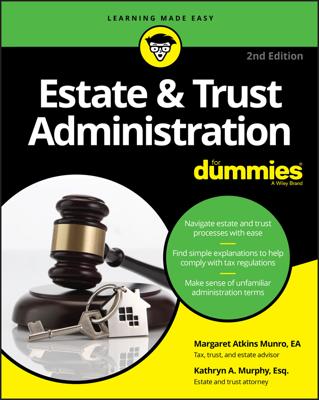When trusts and estates give income payments to beneficiaries, those payments carry income tax consequences for the trust or estate and for the beneficiaries. The trust or estate receives a deduction, and the beneficiaries must include the amount deducted from the Form 1041 on their individual Form 1040.
Form 1041, Schedule B synthesizes all the important information into the all-important income distribution deduction.
To complete Schedule B, follow these steps (unless the trust or estate is in its final year):
-
Take the total from line 17 on the front of Form 1041 (line 1).
-
Add that total to the adjusted tax-exempt interest, which is nothing more than total tax-exempt interest less fiduciary and other fees allocated to it (also known as the contents of line 2).
-
Enter the net capital gain (flip your tax return to its front, and place the number you see on line 4 onto Schedule B, line 6 on the back).
-
Subtract that number from your total of Schedule B, lines 1 and 2, to arrive at the distributable net income (DNI), or the total amount that could possibly be taxed to the beneficiary.
To calculate TAI, add lines 1 through 8 from the front of Form 1041 and the tax-exempt income from line 1 of “Other Information” on the back of Form 1041. Subtract capital gains or losses (line 4, Form 1041) and all fees and expenses that you charged against the income earned in the trust.
Exclude fees and expenses charged against principal (including whatever fees you paid from the capital gains) when calculating TAI. Also, don’t allocate any of the income fees you’ve paid between taxable and tax-exempt income.
On Schedule B, line 11, you put the total amount of distributions made from the estate or trust to beneficiaries during the tax year. These amounts may be mandatory. For example, in the case of a simple trust, all income must be distributed in the tax year that you’re preparing the return for.
In this case, one of three scenarios may apply:
-
If you’re required to distribute all, or any part, of the trust’s income, place the amount you’re required to pay to the beneficiary (even if you didn’t actually pay it) on line 9.
-
Any amounts of income you paid to the beneficiary at your discretion, but that weren’t mandated by the trust instrument, belong on line 10.
-
The total of lines 9 and 10 belongs on line 11.
Now that you’ve calculated line 13, you need to also arrive at line 14. Just subtract line 2 of Schedule B from line 7 and place your answer on line 14. Compare lines 13 and 14. The smaller of the two is the income distribution deduction. Place your answer on line 15, Schedule B, and then carry the result to line 18 on page 1 of Form 1041.

